Why Melodramas Are Scarier Than Horror Movies
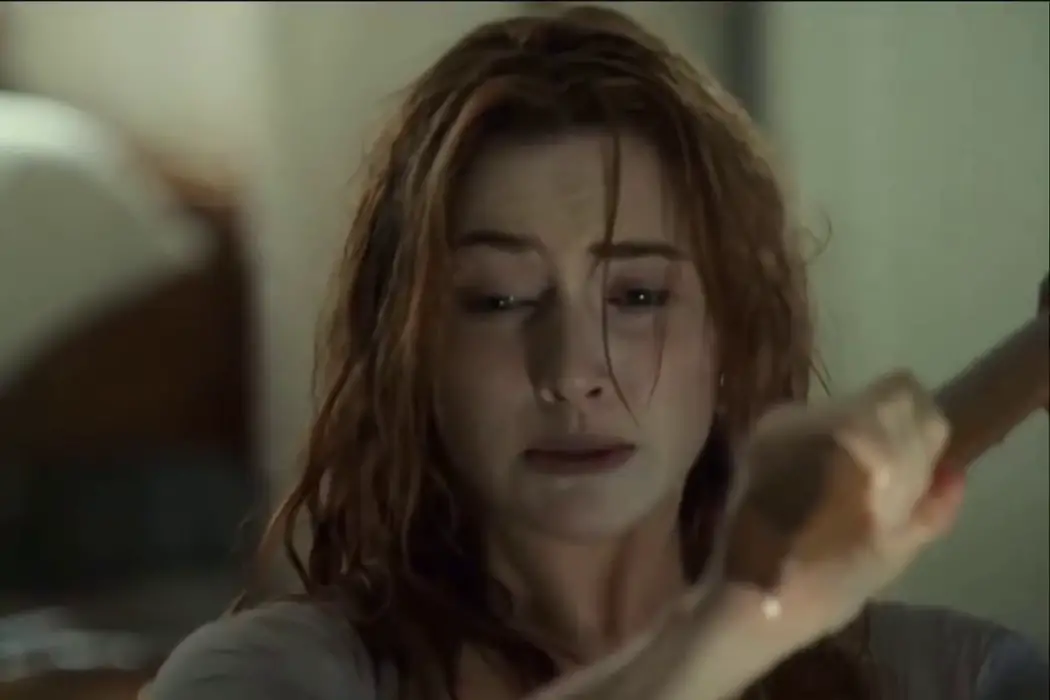
Payton McCarty-Simas is a freelance writer and artist based in…
The first movie I can ever remember giving me nightmares was 50 First Dates. While on its face having nightmares about movies like this Adam Sandler romantic comedy-drama may seem silly, this anxiety is one I’ve discovered that I share with other lovers of horror – and argue about with many of my more rom-com and melodrama-inclined friends who find my affection for scary movies masochistic. While scholarship as far back as the 1940s has repeatedly refuted essentializing claims that horror is for men and romance is for women, this prevailing notion still colors the way we talk about the two genres, dismissing one or the other in turns depending on our preference (sometimes with such vehemence that one romance fan I discussed this article with said it was “mean” to even suggest a connection between the two).
In reality, for all of their popular and critical dismissal, horror and romance are two of the most successful film genres to date: the sumptuous romantic epic Gone with the Wind (whose uniquely horrifying brand of racism is beyond the scope of this article to discuss), remains to this day the highest grossing film of all time, unsurpassed since its release in 1939. Meanwhile, on any given week at the box office, audiences’ morbid delight with films like Scream VI, Smile, and M3GAN consistently electrifies an otherwise dreary post-pandemic theatrical landscape.
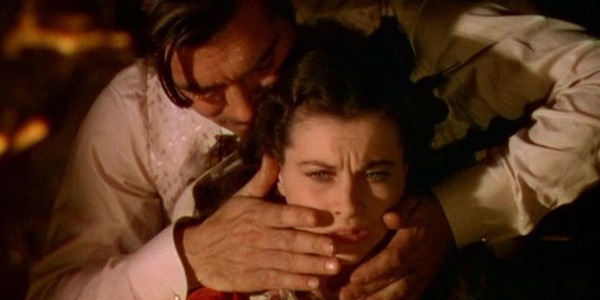
The two genres share so much in common – in the way, we watch them, in the way we react to them, their pacing and structure – but these connections tend to end up overlooked or used to distance melodrama from horror and recuperate “women’s horror films” like Twilight by emphasizing their non-horror aspects. Here, I want to argue that melodramas may look and sound different than their gory counterparts but are often more frightening. They, like most great scary movies, serve as a testing ground for enduring the daily terrors of womanhood and allow for a restorative catharsis of emotions that we may characterize as sadness, but that are often predicated on the same types of situations played out in horror films.
Horror or Melodrama?
This Valentine’s Day, in the process of trying to pick a rom-com, one of my friends asked me to watch The Notebook with them – a film I’d already seen and vowed to never watch again. People often assume that as a horror buff, I don’t like rom-coms. This isn’t true. That being said, I have contended as often as I could squeeze it into conversation (at weddings, at bars, in film courses) that within a broad genre that’s been historically categorized as “the women’s picture,” or “the melodrama,” but that we now typically lump in with the rom-com (even when they’re not particularly comedic and can be better defined as “romantic dramas”), some of these films are far scarier than the horror movies I watch with abandon.
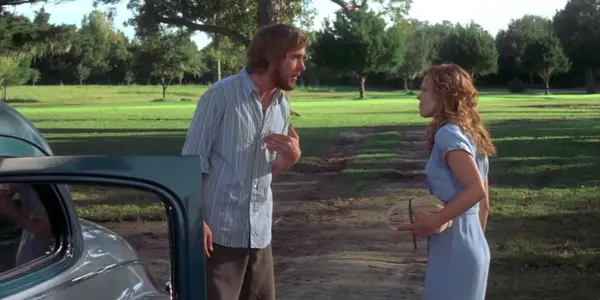
While I love the films of John Hughes or Nora Ephron, more hardcore romance films like The Notebook take a darker approach to the romance genre that occasionally sends shivers down my spine. Consider the premise: “An institutionalized elderly woman with dementia is forced by her dying husband to ritualistically relive their tragically doomed young romance on a daily basis in order to attain an almost supernatural, brief moment of lucidity that quickly fades, leaving an even deeper sense of confusion, entrapment, and isolation in its wake, necessitating forced restraint and sedation. The film culminates in the couple’s grim death.” It sounds more like the plot of Relic or Psycho than what we’d expect from a romance.
So, too, with 50 First Dates: “A man falls in love with a woman who suffers from anterograde amnesia, winning her affection every day for years until the couple marries. At the film’s end, the woman, under the impression she is five years younger and living with her family, wakes up on a boat in the Arctic with a strange man who insists he is her lawful and doting husband, a young child he insists is hers, and no recollection of her pregnancy.”
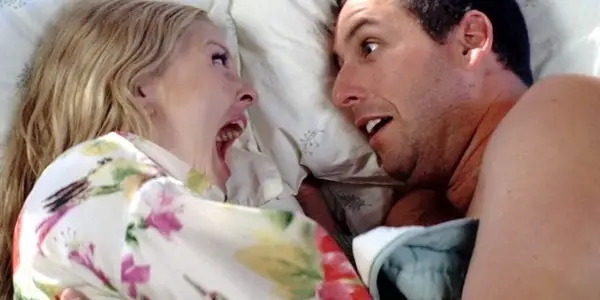
Considering the practical implications of this utterly fantastic form of psychological torture, genuinely worthy of its own Saw or Don’t Breathe film, it’s surprising that the script’s choice to play it off as an idiosyncratic obstacle to be overcome by Adam Sandler‘s undying affection is as successful as it is – and therein lies my terror. To deny these films’ horrific elements is to circumscribe a long history of generic overlap.
Paranoid Women’s Films and “Temporary Pain”
Beginning in the 1940s, film trade journals and fan publications began to take note of a shift in the audience for horror. As Tim Snelson points out in his book, Phantom Ladies, newspapers in the early war years reported that “according to movie surveys, women are more enchanted by horror films than men,” defying previously held contentions that horror films were unladylike and masculine. Indeed, according to film scholar Shelly Stamp in her essay on women and the production of film noir, women producers of that genre were at the forefront of challenging assumptions around women’s taste: Joan Harrison, the first female screenwriter to be nominated for an Academy Award for Best Original Screenplay in 1940 and producer of classic “paranoid women’s pictures” like Rebecca (1940), told Collier’s magazine that “there’s nothing lovelier than a nice, juicy homicide” in a movie, pushing back against the notion that women were primarily interested in romance. It is important to note here, though, that many of these 1940s films did include romantic elements, emphasizing that horror for women shares DNA with melodrama.
Film professor Mark Jancovich argues that the moniker “paranoid women’s film” was, at the time, commonly understood to describe a loose subgenre of horror films about women, indicating again that the two genres weren’t always so diametrically culturally opposed. The term was attributed to a broad range of films from gothic romances like Alfred Hitchc*ck‘s Rebecca to film noir like Suspicion (1941, also Hitchc*ck). Both films depict women frightened of their men and the threat of domestic violence, financial abuse, and mariticide. Jancovich also points out that, while Hitchc*ck was known as “the master of suspense” (due in no small part to these paranoid women’s films), he was also called the “Mahatma of Melodrama” – a title linking him to that other, more acceptable type of women’s entertainment, the romance, and, in so doing, tacitly conflating the two. Is Marnie (1964), with its sexual violence and gaslighting, its star-crossed romance, and its slapstick comedy more a horror film or a romance? A thriller or a drama?
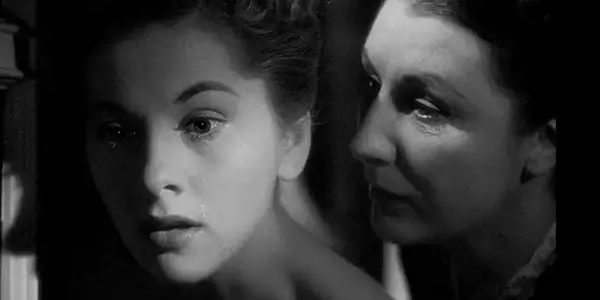
Hitchc*ck himself made the case that melodrama and horror share something fundamental in a 1964 interview with the BBC. Hitchc*ck first asserts that he makes his films for women because “80% of the audience is made up of women” – the other 20% being their dates – ascribing a love of fear to his presumed female audience. Then, when asked about the suspense elements of his films, he replies that his central goal is to leave audiences “giggling like the woman who comes out of… the very sentimental movie, and says, ‘Oh, I had a good cry’… with tears rolling down her cheeks, she says, ‘Oh it was lovely, I cried my eyes out.'” When Huw Wheldon, the interviewer, presses him on the point, asking what arouses the feeling of a “good cry.” Hitchc*ck concludes that both the tender romance and the “agonizing” suspenseful thriller provide the audience member with “the satisfaction of temporary pain” relieved.
“Body Genres” and What Makes Us Cry
Contemporary analyses of horror spectatorship have worked to bring horror and melodrama together, but in the process often only opt to draw connections through horror’s romantic elements rather than melodrama’s horrifying ones. Brigid Cherry‘s 1999 survey of women horror viewers, “Refusing to Refuse to Look,” for example, works to untangle her subjects’ appreciation for the genre, comparing them to readers of dark romantic fiction. Through this connection, she argues for the validity of a “feminine” perspective on the “masculine” horror genre – albeit often at the rhetorical expense of horror itself. She emphasizes her subjects’ appreciation for the romantic “tragedy” of vampire films and the empathetic pathos attached to horror monsters: as one subject tells her, “Monster films always make me cry.”
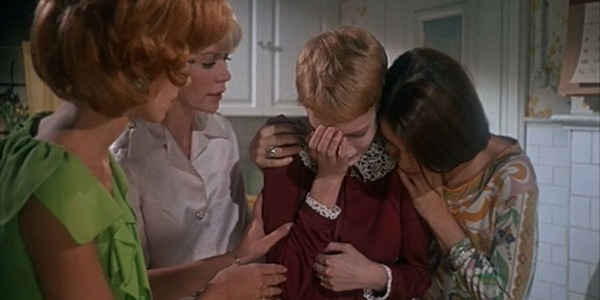
Similarly, Constanza del Río argues in her analysis of Martin Scorsese‘s Cape Fear (1991) that horror’s interest in “exploring the dissatisfactions latent in the nuclear family and in dramatizing culturally repressed psychosexual conflicts within this social institution… links [it] in an essential way to domestic melodrama.” That said, her argument undercounts how literal situations of anxiety and expressions of fear inflect those conflicts – the “psychosexual conflict within the social institution” at hand, in this case, is, literally, personified by a serial rapist stalking a teenage girl. Simply put, by focusing on the way horror can sometimes make us cry, we ignore the way melodrama sometimes makes us scream – or, more importantly, how sometimes fear makes us cry too.
Part of the challenge of connecting the two genres is exemplified in feminist scholar Linda Williams‘ seminal essay on what she calls film’s “body genres.” In it, she contends that horror, melodrama, and pornography – the “lowest” or most disreputable and “excessive” genres – evoke different strong, physical reactions (screams, tears, and orgasms respectively) based on the way they time their most important plot points. Horror, she argues, is a cinema of “too early!” wherein victims are caught before they’re prepared to face the monster that hunts them, while melodrama is a cinema of “too late!” in which lovers meet only to lose one another, understandings between parents and children are reached, only for one to die, etc. This isn’t entirely true, though.
Horror often relies on the helplessness of “too late!” to function – while the victims may not know the monster is coming, the audience often does, aided by POV shots from behind doors, outside windows, or under beds. Much of a horror film’s runtime is dedicated to convincing the unbelieving or warning the unexpecting, hewing the viewer not to an unknowing victim but to an already-terrified Cassandra, from Nancy in Nightmare on Elm Street to Rosemary in Rosemary’s Baby to Jay in It Follows. As the hero of the original Invasion of the Body Snatchers (1956) tells us in his unheeded and haunting final monologue about the titular aliens, “They’re here already! You’re next!“, implying not “too early!” but the even more terrifying “too late!” Reorienting the genre’s temporality this way could help make sense of the creeping horror some of us feel when watching The Notebook – for Lucy, the bewildered amnesiac in 50 First Dates, or Allie in The Notebook, it is indeed “too late!” – without pitting the two genres against each other, distancing the melodrama from the horror it embodies.
Titanic and the Horror of Womanhood
Much of the horror of melodrama can be tied back to another conclusion Brigid Cherry draws in her essay: both genres can be used to “help [women] deal with their everyday lives.” Within a hetero-patriarchal system, the subject of many melodramas is predicated on the horrifying “too late!” -ness of the structure of women’s lives. Consider one of the more obviously scary melodramas and the third-highest-grossing film ever: Titanic. Hailed as one of the best love stories of all time and beloved by teenage girls everywhere, the film’s 25th-anniversary theatrical re-release (ongoing through this week) topped the box office over new releases in a shocking break from typical re-release expectations. Only one month after its initial release in December 1997, a survey found that 7% of American teen girls had already seen the over three-hour-long film more than once, suggesting that the film’s morbid power holds a unique way for young women and harkening back to Joan Harrison‘s quip about women moviegoers’ bloodlust.
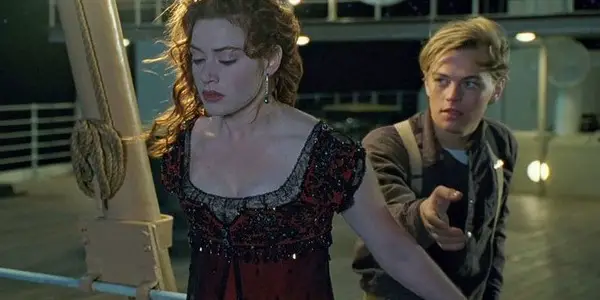
The horrific elements of the film begin far before the iceberg strikes, with the brutal reality that Rose’s family is relying on her forced marriage to an uncaring abuser for their financial security. The entire film is predicated on parallelling this horror with the tragedy of the ship itself, told largely in the language of a ghost story. The audience is shown real footage of the wrecked RMS Titanic, foregrounding the tangible tragedy before centering on the none-too-cheerful romance at hand, itself predicated on Jack’s (un)serendipitous admittance onto the ship that will become his coffin (“too late!”). The two characters’ meet-cute is Rose’s almost-successful suicide attempt spurred by her impending marriage, a threat that looms over the character’s heads.
As their love blossoms, Rose warns the ship’s captain that there are insufficient lifeboats and the crew consistently fails to take safety precautions (“Did we ever find those binoculars for the lookouts?” – “too late!”) as Rose’s betrothed becomes progressively more threatening. The romance is largely put on pause for approximately an hour and twenty-four minutes in order for the audience to witness the tragic-horrifying deaths of 1,517 people, taking on the visual language of both disaster and horror films in turns. As in most traditional horror film structures wherein overcoming the monster leads to greater personal strength for the final girl, only once Rose has undergone her ordeal on the Titanic is she able to leave her husband-to-be and self-actualize as a financially independent, liberated actress. (From a horror perspective, Rose is clearly Titanic‘s final girl, running through flooding corridors wielding an axe and improbably surviving one of history’s greatest disasters.) Typical analyses like del Río‘s argue that, for all their similarities, “melodrama ultimately manages to expel evil from the world” where horror doesn’t. However, this framework simply can’t account for the impact of the (myriad) lingering traumas often inflicted on the melodrama film’s characters: Even if Rose’s heart will go on, she still has to watch thousands of people freeze to death as she holds Jack’s dead hand.
Conclusion:
Ultimately, to argue that melodrama contains horrific elements isn’t an insult to the genre, it’s a testament to the ways in which both genres serve as an outlet for women’s fears and challenges. Hitchc*ck‘s invective, “Torture the women!” suggests more than killers behind shower curtains. The uncanny thing about these melodramas that makes them almost scarier for some of us to watch is that, unlike horror, many melodramas like The Notebook don’t seem to acknowledge the more frightening elements of their plots – calling Titanic “the greatest love story ever told” leaves more than a few things out, Rose’s suicidal ideation being the least of them. Emotions are complex, and the anxieties on display in even the most tonally lighthearted romantic drama are tacitly undergirded with serious questions women face, from A Streetcar Named Desire to A Star is Born: “Will he fall in love with me?” “Will I be able to achieve financial security?” “Will he abuse me?” “Am I safe?” Really engaging with the dark notes in these films can elevate their power even for those who enjoy them – after all, as Rose says at the end of Titanic, “a woman’s heart is a deep ocean of secrets.”
Does content like this matter to you?
Become a Member and support film journalism. Unlock access to all of Film Inquiry`s great articles. Join a community of like-minded readers who are passionate about cinema - get access to our private members Network, give back to independent filmmakers, and more.
Payton McCarty-Simas is a freelance writer and artist based in New York City. They grew up in Massachusetts devouring Stephen King novels, Edgar Allan Poe stories, and Scooby Doo on VHS. She's currently earning her MA in film, media, and sexuality at Columbia University, focusing their research on horror film, science fiction, psychedelia, and the occult in particular. They live with their partner and their cat, Shirley Jackson.













